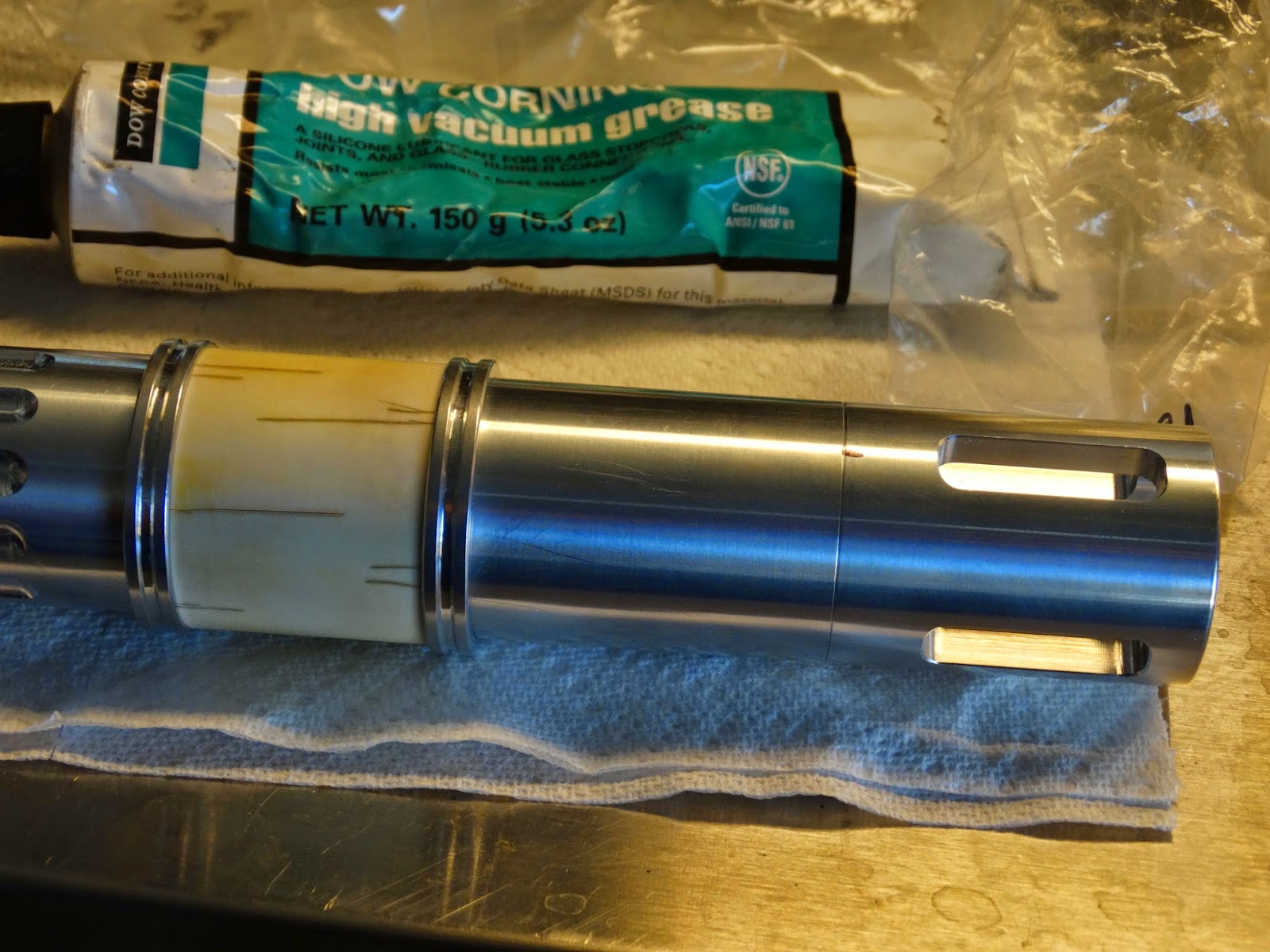So, it's measure twice?
As I owned up to in my previous post, I made my previous fake bone cover just a bit too big. I did measure twice, but I did also make a mistake. I measured the piece I'm covering based on the previous version. In the previous version, I didn't have pieces that "fenced" the fake bone piece in place. While it is obvious that I should have accounted for them, I took a short cut and used the physical dimensions of the piece rather than putting the whole thing together and taking the measurements. It was an obvious mistake.The above is the new configuration. The fences surround the crystal chamber - they'll keep the fake bone piece from sliding up and down the saber when finished.
Now, I measure again. The space is 1.3495 inches. While the crystal chamber part is 1.5 inches on the face, the "fences" remove some of the space. It is interesting to know, that 1.3495 is still slightly too big. If I made my replacement part using this measurement, the fake bone would jam against the "fences" and won't turn. So, falling back on the rusty wheels of my experience machining parts, I take a guess that the fake bone piece should be cut to 1.3485 inches (or exactly 1/1000 of an inch shorter). Using the same process as I did in my previous post (so as not to bore you repeating it), I made three new pieces.
They all fit. Yay! I took this picture to show how the part looks without making it look like bone. The picture below shows a closer look at this particular part.
Taking only one of these parts, I go through the process of making the PVC fake bone look more like real bone. Using an X-acto knife and three colors of paint (along with the liberal use of paint thinner), I have a fake bone on the saber.
As you can see, the fake bone part is in place. This is actually the third and thinnest walled part because I am really looking forward to taking advantage of the translucence of the PVC when I can finally put the electronics into the saber. I haven't cut the part to view the window in the aluminum underneath.
As you can see, I placed a dot on what may be the "top" of the saber. The dotted window actually corresponds with a window on the crystal chamber. Before I cut the window, I want to figure out the size so that I cut it right (I'd like to keep the other two parts on the bench in case I mess up again).
The Tube of Lube…
In the picture above, there is a tube of Dow Corning High Vacuum grease. That's not there for show or scale; it's there because that's the grease I tend to use in my projects. In this project, the parts are aluminum and are subject to "welding" when fitted together (although, it's more problematic with stainless steel, in my experience). This grease is pretty interesting: it's a silicon (or silicone, I switch them sometimes) grease. It is waterproof, so it won't wash away in water, nor is it subject to degrading due to high humidity. Anyway, I liberally applied this to the threads of the saber parts before putting them together. I'll probably apply a few more treatments as I work on the saber.An insane idea.
In my last post, I expressed an interest in the translucent qualities of the PVC when turned thin for making these fake bone parts. The idea I had won't seem insane at first blush: I want to try engraving lettering (in a Star Wars font) on the fake bone. The lettering will look cool when the saber comes on. Don't believe me, look at this part with a light shining into it to simulate a very bright crystal chamber.
Why is this an insane idea? Well, engraving lettering on a part is a job for a CNC Machine. That is, a computer controlled machine turns and carves the part, putting the lettering in as it turns and cuts. Unfortunately, all I have access to in pure machining power is a lathe, a milling machine, and a few interesting gadgets for them (like a rotary table with dividing plates). Without a CNC Machine, I can easily cut verticals and horizontals in letters, but diagonals are a very difficult or near impossible task. I'd have to plunge drill along each letter to a specific depth. It's messy and extremely time consuming, but possible. It's simply so time consuming as to be impossible for any practical application. The challenge is to create lettering in an elegant first pass without extra clean-up afterward.
However, a challenge is just that. The key to making my idea work is to create a jig that allows me to cut a set of letters based on a stencil. I've spent the last few weeks since the last post racking my brain on how to do this. It's obvious to me that I have to have a stencil, a support to hold the part so that I can manipulate it with my hands while the mill spins an engraver, and a guide so that I only cut the marks of the letters and nothing else. I'm hopeful that I can make this, but it will probably be the most complex jig I'll make in my lifetime.






















